1 – Context of the study
All studies and analysis highlight the importance given by the governments, both developed countries as emerging markets, to Information and Communications Technologies (Aldrich et al, 2002). This strategic importance given to ICT is doubly justified: First, the economic sector where the information technology and communication is the largest source of jobs creation (Fang, 2002).
Second, the transverse effect of these technologies by placing them at the forefront of structuring the economy and society as a whole (Chen, 2002).
The Moroccan government has made the introduction of information technology and communication within its administration a priority (Talbi, 2007).
The following extract from royal speech attests to this reality. “…. The strategic significance of the new economies, coupled with the profound and rapid changes that it operate as a prelude to the emergence of the knowledge society and communication, imposes a duty to upgrade, to give our country the ability to master new technologies and operate optimally, the tremendous opportunities they offer to us. .. ”
The results of this study should inform and support public policy guidelines for training and qualification for the skills related to the integration and use of information and communication technologies within the Moroccan government.
There is no need to stress the valuable contribution of ICT which are currently the best tools for decision support and that can have a positive impact on the process of modernization of the Moroccan administration (Hajji, 2001).
The various projects to integrate ICT within the Moroccan administrations have lead to an opportunity to rethink the relations maintained between the Moroccan government and citizens (Ourzik, 2005): Valuing close relations, service quality and ease use of administrative procedures.
The proposed digital administration (DA) in Morocco commonly called e-government project1 is undoubtedly one of today’s most promising issues by which access to public services offered by the Moroccan government can be both based on human relations and closer to the expectations of citizens and socio-economic actors (Sahim, 2006).
In Morocco, the project fits into the digital administration e-Morocco Vision 20102, which is a support functional modernization of the Moroccan administration and having a direct impact on human resources development and evolution the structure of jobs within those administrations. The general research questions of this study are:
- What conclusions can we draw about the proposed digital administration (DA) carried by the Moroccan government?
- What new information and communication technologies skills are induced by the integration of ICT projects within the Moroccan government?
- What are the factors that most influence on the decision to integrate ICT within the Moroccan administrations?
- What are the factors that determine the success of integration ICT projects within the Moroccan administrations?
- What are the features (functional and technical) of integration ICT projects within the Moroccan administrations?
|
1 Project e-government is the designation agreed for all projects developed to automate services offered by the Moroccan administration.
2 Long term orientation to integrate Morocco into the society of information and communication. This document was prepared in 2007 by the Ministry of Industry and new technologies
|
- Synthesis of the literature review
- The integration of ICT in the process of modernizing the administration offers several advantages. For the administration, these include: The increase in the number of recipients of the services offered (Daniel and Forman, 2002);
- The decrease in operating costs of government (Heeks, 2001);
- The acceleration of trade and on-line administrative services (Laudon & Laudon, 2001).
The concept of the digital administration offers a simplified, faster, more complete service to citizen, regardless of its location (St. Amant, 2003).
Our literature review will be structured as follows: The first section provides a definition of digital administration and highlights its advantages and conditions for success. The second section presents a framework for development of digital administration with its four phases. The third section will be dedicated to the development of a review and state of achievements of the integration of information technology and communication within the Moroccan administrations.
The fourth section describes the relationship between the existential structure of Human Resources and the evolution of the integration of information technology and communication within the administration.
The concept of the digital administration offers a simplified, faster, more complete service to citizen, regardless of its location (St. Amant, 2003).
Our literature review will be structured as follows: The first section provides a definition of digital administration and highlights its advantages and conditions for success. The second section presents a framework for development of digital administration with its four phases.
The third section will be dedicated to the development of a review and state of achievements of the integration of information technology and communication within the Moroccan administrations. The fourth section describes the relationship between the existential structure of Human Resources and the evolution of the integration of information technology and communication within the administration.
2.1 Digital Administration: Basic concepts and definitions
The digital administration is a concept that has emerged in public administration and services of the States in the late 1980s.
Some definitions emphasize either on the effective management of Administration (ITA, 1999) or on improving the quality of services to citizens (Hirst & Norton, 1998) or on a new governance adopted by the Board (Alberta, 2000). We cite three important definitions for the rest of this study.
- “… The digital administration was the adoption by the various public institutions and state bodies of new information and communications technologies in their relationship with citizens, employees and partners in public or private service … “(Arthur Andersen, 2000).
- “… E-government […] is not just about service delivery over the Internet […] The far more daunting challenge in the years ahead Is a revolution in governance Itself, has revolution in the fullest Meaning of The Word – A Dramatic Shift in That the ways politic and social power is organized and used … “(Alberta, 2000).
- “… The digital administration is a process that allows the use of the Internet to: (a) provide services to clients and companies, (2) to enable government organizations to connect employees, suppliers and customers and (3) transform government operations also including government relations – Government .. “(Jhonston, 2001).
The first and third definition insists on the adoption and use of ICT by government to transform its relations with various partners such as citizens, businesses and social institutions.
The second definition puts more emphasis on the transformation of modes of governance that can allow ICT. Even if the definition of digital administration is constantly changing, two ideas emerge from all these definitions and that can be applied on the evolution of digital administration in Morocco:
- The adoption and integration of information technology and communication in the business processes of government. This adoption pushes governments to adopt new modes of governance us part of a deliberate policy of opening and modernization of management tools;
- The transformation of government relations with all stakeholders internal and external citizens (individuals and firms), suppliers, employees, communities, and regions, associations and other stakeholders.
2.2 General framework for the development of Digital Administration
Different authors emphasize the near-requisite organizational and environmental success of the implementation of digital administration (St. Amant, 2003, Anderson, 2000).
These different requisites are inserted into a conceptual framework divided into four phases: 1. The phase of information, 2. The phase of the interaction, 3. The phase of the transaction and 4. The phase of integration. This framework is often used to assess the maturity of the digital administration of a country (Parado, 2002). Studies on the evolution of digital administration have shown that the governments of industrialized countries have reached the phase of interaction or the transaction phase by making minor organizational changes (St. Amant 2003).
The fourth phase implies that ICT are highly integrated to support the integration of services and new organizational structures. Another way to define the digital administration is using the main stakeholder of e-government project, which may be:
- Intra-organizational: Projects aimed at improving the effectiveness and efficiency of its internal processes and organization performance;
- Organizations – Citizens (O-C): Projects that aim to improve and distribute the process of providing public services to citizens (individuals and businesses);
- Organizations – Enterprises (O-E): Projects aimed at improving relationships and interactions with businesses and freelance workers who provide services / products;
- Inter-organizational (O-O): Projects that aim to achieve the link and inter-organizational integration between different administrations through a single entry (“one-stop servicing”).
2.3 The project of the Digital Administration in Morocco: State of the art and future trends.
Morocco, like most African countries would face the effects of globalization that are reflected by the opening of borders and the dismantling of tariffs and customs in 2010 (Maryniese and Savoye, 2002) . Economic openness imposes imperatives of competitiveness and overall performance.
The Ministry of Modernisation of Public Sector3 (MMSP), created to modernize government management tools and work. The ICT are at the heart of this upgrade and are used by the Department of modernizing the public sector as a lever for change and a factor of major restructuring of each administration (Anderson, 2002).
|
3 Department creates tools to modernize management and labor within public sector institutions in Morocco. Since its creation, the department works to implement modern management tools and piloting various modernization projects in various administrations.
|
The different trends across the world show that in the coming years, the intelligence and knowledge are the main source of economic wealth of countries (West, 2001).
These two factors are of extreme importance for the competitiveness of Morocco at international level (Ourzik, 2005). In its modernization plans, the Moroccan government is more interested in the development and redefinition of the government operating as a network and synergy rather than marginally, to promote the exchange of information.
Having become aware of all issues of ICT and their impact on the modernization of the administrative institutions, the Moroccan government did not remain quite foreign to that fact.
Different directions are taken, we cite for example: 1 – The need to improve relations between administrations and users, which at the same time is a democratic necessity and is an essential component of the modernization of the State, 2 – Simplification of administrative procedures, 3 – Better use of information technology to simplify the formalities and particularly by intensive use of ICT.
Since 2002, several initiatives have been taken and have lead to positive developments in several areas. Thus, at the initiative of the Moroccan government, the e-government committee was formed in February 2003 in order to contribute to the implementation of the national program of “e-Government”.
Under the leadership of this committee, many projects were initiated which lead to some concrete achievements and development of the first online services such as E-Customs , E-bds of the National Fund of Social Security and E-Justice.
Currently, the Moroccan government has embarked on a gradual process of computerization of its services. Most of the computerized procedures have a scope within Ministerial although some of them, such as projects of the Integrated Management of State Personnel allows data exchange at ministerial level.
In this context, to strengthen the coordination of the national strategy and action of the Moroccan government in this area, an extensive program of promotion and development of new technologies in the administration has been initiated through the Department of Public sector modernization.
The program is called IDARATI: Computerisation of the Departments of Administration and networking technologies through adequate information). The follow figure show the evolution of on line service offered by Moroccan Administrations.
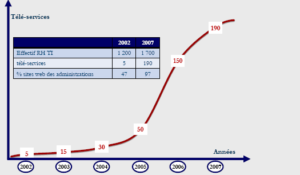
Figure 1: Evolution of On line services offered by Moroccan Administration (between 2002 and 2007)
2.4. Emergence of digital administration, and impact on the evolution of ICT skills
There are very few studies focusing on understanding the development of “new business” following the integration of ICT in the Moroccan administration.
Most available studies pointed the classical categories of professions related to information technology and communication, namely the traditional crafts of computer and information systems. In this context, our literature review suggests a state of the art research on job and professions related to ICT, and we considered the main contributions as a repository that we could compare the results empirical investigation.
The European model (ITA, 2000) structural analysis of job-related ICT, offers a classification and nomenclature. All researchers in the field of technology Information and communication agreement on a standard for defining competencies related to information technology and communication called e-skills with three levels, namely:
- Digital Literacy, which includes all the skills to use basic information technology and communication as a learning tool in everyday life and work;
- The ratings for uses that involve the ability to use technological tools in the work situations of the most common and the ability to update these competencies when working procedures, organizational arrangements or applications change;
- The professional qualifications of information technology and communication which are required in the sector of information technology and communication in order to design, develop, implement, manage or make day technological applications.
The European Commission proposes a model for mapping professions related to information technology and communication that relies on four main groups of occupations and jobs as shown in figure below.
This classification is taken into account in our study to understand the changing structure of jobs related to ICT within the Moroccan government.
At the center, we find the occupations classified as “hard core” of the core skills of computing: software specialists, networks and systems. A first peripheral group consists of professional Internet and multimedia, which combines skills in graphic, artistic or editorial.
A second peripheral group consists of business related applications of information technology and communications with generic common to many companies and organizations: ERP, systems management customer relationship platforms of electronic commerce, electronic exchange of business data and e-government.
Professionals in this category are mostly graduates of training courses for advanced or intermediate. Among the technical skills of these professionals, in addition to hardware and software aspects are the skills related to network design, communication protocols, transmission of data integration software and hybrid systems.
3. Empirical Study
3.1 Research methodology and approach
Researchers in management an implementation of ICT consider two possible orientations to undertake a study on changes in jobs related to the integration of information technology and communication (Thietard, 1989).
First, a study on the content, and secondly, a study on the process. The orientation of the former tends to highlight the elements that make up the research topic studied by cons, processual orientation tends to explain the evolution and behavior of the studied object in time. In this study, the various issues under consideration attempt to explain the skills and jobs emerged following the integration of ICT within the Moroccan government.
The nature of research questions point us to adopt an approach to research on the content. Besides the nature of the research object, we took the approach of research action as a basis for our empirical investigation. Indeed, for over fifty years a specific approach in management science that is called action research has emerged and developed in the world, including from the United States.
In 1986 at a symposium at the National Institute for Educational Research in France, researchers have defined action research as follows: “… This is research in which there is a deliberate transformation of reality; Searches with a dual objective: to transform reality and generate knowledge about these changes … “(Hugon and Seibel, 1988).
For Lewin (2001), research action is defined as a search comparing the conditions and effects of different forms of social action and leading to social action. The response to our general research questions will be greatly facilitated by adopting research action approach.
3.2 Architecture of the questionnaire
We relied on a questionnaire for collecting information from government surveyed. The questionnaire is divided into four parts.
Part 1 (Identification of the respondent): This part of the collection of data on the administration surveyed while differentiating their status (Administration Office or Department). The information on the respondent are also requested in this part.
Part 2 (Identification of projects): This section concerns the various projects to integrate information technology and communication within the administration. In this part, we are interested in the nature of these projects and their strategic importance in the process of modernization of the Moroccan administrations.
Part 3 (of the existing state of information and communication technologies): In this part of the questionnaire, we focus on solutions and technology choices implemented in the administration. The term Back Office, means different processes and areas of integration of information technology in internal administration. The term front office refers to the various processes of communication between the administration and its various external partners (Citizen, National, Business, etc. …).
Part 4 (Impact of the integration of ICT projects on the creation of jobs): In this part of the questionnaire, we investigated the impact of integrating information technology and communication on developments trades and jobs in the Moroccan administration. We relied on a repository of trades and jobs developed in the project MEDA24 which includes a comprehensive list of jobs and professions related to information technology and communication existing in Morocco.
|
4 Support the development of vocational training in the areas of information technology and communication. This project is funded by 75% by the European Community.
|
The following table presents a complete list of 21 trades included in this study.
Table 1 : Benchmark jobs related to information technology and communication considered in this study.
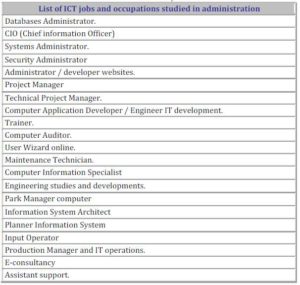
3.3 Final sample of the study and characteristics of the respondent
The sampling procedure pursued in this study was non-probability type5. This sampling procedure is described by Tremblay (1991).
This type of sampling gave us the opportunity to select a set of Moroccan government representative of our study. We relied on the following criteria for the development of our study sample:
1 – Relevance of integration projects in the administration,
2 – Importance of the role of government in the public sector,
3 – Importance Administration regarding its accession to the E-Morocco 2010.
|
5 According to Tremblay (1991), the procedure uses a non-probability sampling method that does not assess the probability for each unit of the population considered to be sampled, or to ensure that all units of the population of be included in the sample.
|
The following table lists the administrations concerned by our study.
Table 2: Composition of the sample
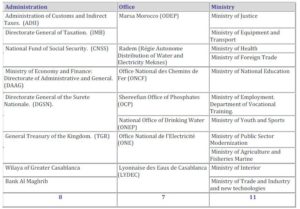
In total, we were able to drive 50 semi – structured interviews with senior officials of the Moroccan administration. The average duration of these interviews did not exceed 2h:00 minutes.
4. The development of empirical results of the study
In this section, we focus on the development results of the study and answer the various questions of the study.
4.1 Development of descriptive statistics and indicators on the basis of relevant administrations.
4.1.1 The basic specifications on project integration
The following table presents the characteristics of the integration projects of information technology and communication within the sample surveyed. We have analyzed three important features: The mode of integration and implementation of projects, the nature of projects and finally the average time of completion.
Table 3: Key indicators on the integration projects of information technology and communication within the Moroccan administration
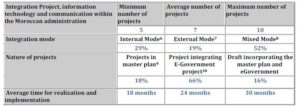
|
6 The internal mode is the realization of integration projects with internal resources to the administration.
7 The external mode is the realization of integration projects with resources outside the administration. The entire project is assigned for its implementation to an external enterprise
8 Mixed mode is the realization of the integration of ICT projects by both internal resources and external resources to the administration.
9 These projects are generally join in a computer master plan established for the development of information system of the Administration concerned. The majority of projects identified in this first part concerns the automation of internal processes of the administration.
10 These are projects within the framework of e-government and allow for online services Administration
According to Tremblay (1991), the procedure uses a non-probability sampling method that does not assess the probability for each unit of the population considered to be sampled, or to ensure that all units of the population of be included in the sample.
|
The nature and purpose of development projects line of the administration are presented in the following figure.
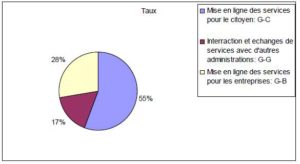
Figure 3: Nature and purpose of development projects in line administration
The previous figure shows that development projects are dominated by online services to citizens. 28% of the projects concern the development of exchanges between government and business, and finally 17% of the projects concern the exchange of data between administrations. The following figures shows the relative importance of factors for the decision-making integration of information technology and communication within government surveyed. 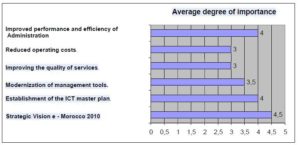
Figure 4: The importance of factors of integration projects information and communication technologies within the Moroccan administration
The analysis of this graph clearly shows the emergence of three factors supporting the decision to integrate technology projects within the Moroccan administration:
- Improved performance and efficiency of the administration: This factor refers to the process of modernization that is currently the master project within Moroccan administration;
- The completion of the implementation of the strategy of the administration on its master IT plan
- The integration of the administration’s strategy in E-Morocco 2010.
The availability of resources, the total involvement of various parties in the project and clear identification of needs are classified among the first factors encountered by those responsible for the success of integration projects of information technology and communication within the Moroccan government.
4.1.2 The technical characteristics of ICT projects within the Moroccan administration.
This section is reserved to the development of basic statistics on existing applications in the information systems of administrations that have participated in our sample. The following table shows the different areas of Back Office Automation government and their level of efficiency and modernization.
Table 4: Field of automation (Back Office)
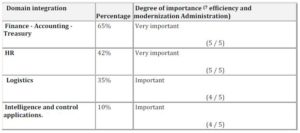
The following figures show the different technologies used for the management of databases, operating systems and development languages used.
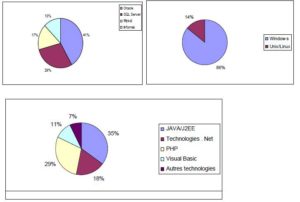
Figure 5: Technology used for developing ICT applications within administration.
Different administrations have experienced an organizational structure with (department, division, service) identified. The following table shows the importance of jobs and trades that contributed to the success of different integration projects Front Office.
Table 5: The importance of jobs and trades that have contributed to the success integration projects Front Office
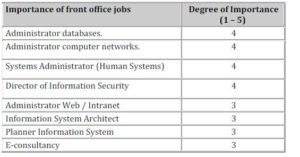
The following table shows the ICT professions and jobs that have been important for the success of back office integration projects.
Table 6: The importance of jobs and trades that have contributed to the success integration projects Back Office
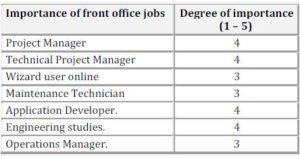
4.2 Identifying the nature of the jobs created through the integration of ICT in the Moroccan Administration.
The following table shows in a qualitative way the nature of jobs created or Impacted in government following the integration of information technology and communication.
5. Conclusion
Analysis of the results of the study shows that in the Moroccan administration, there are ten jobs that are strongly impacted by the introduction of new information technologies and communication and which are:
- Database Administrator;
- Administrator systems;
- Security Officer;
- Administrator websites;
- Project Manager functional;
- Application Developer;
- Architect Information System (Newly created);
- Operator input;
- E-consultancy (Newly created);
- Trainer;
Besides the aspect related to the identification of jobs and trades mainly ICT, our various semi-structured interviews revealed the following points:
Table 7: Qualitative Nature of jobs created in the Administration following the integration of ICT projects
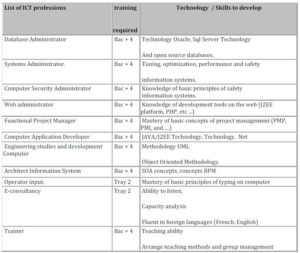
The integration of ICT in the Moroccan administration can be characterized as hybrid. The use of external providers is observed in most cases. The projects involve integrated ICT applications integrated automation of the ICT master plan.
The concept of e-government is in its beginning stage in the Moroccan administrations. Based on the model of St. Amant (2003), we find that these integration projects are in the phase of information and that other phases have not yet commenced due to non-implementation of projects and timeliness of outputs. The success of this integration project depends primarily on the willingness of different administrations.
The qualitative analysis of the needs of Human Resources, ICT has enabled the identification of a set of specific jobs.
It also helped to identify a set of jobs mainly in the emerging field of Internet, Tele-services, offshoring, remote training and regulatory aspects, so that quantitative analysis of jobs identified helped to highlight the most important jobs in terms of numbers and qualifications frameworks and the associated skills.
References:
D. Aldrich, Bertot JC, McClure CR. 2002. “E-government: Initiatives, Developments and Issues”. Government information quarterly, 19 (2002), 349-355.
Allen, July L, Paquet G, Roy J. 2001. “E-governance governement & On-Line in Canada: Partnerships, people & prospects”. Government Information Quarterly, 18, p. 93-104.
Apebi, innovation and R & D strategy Pillars Morocco 2005-2012
Arthur Andersen research. 2000. EGovernement, reflection on the use of new information technologies and communication by the public.
Brucher H. 2002. “A Strategic Reference Models to Develop e-government concepts.” ERCIM – News, No. 48.
Buckstein J.2000. EGovernment. Publication of CGA-Canada.
Carnegie Mellon University. (2002. ESourcing Capabilities Model (escmsm) for IT-enabled Service Providers v1.1
Chen H. 2002. “Digital Government: Technologies and Practices. Decision Support Systems (special issues), 34 (2002) 223-227.
YC Chen, J. Gant 2001. “Transforming local e-government services: the use of application service providers”. Governement information quarterly, 18, p. 343-355.
Daniels ME, Forman M. 2002. E-government strategy, the simplified delivery of services to European experience in e-government development, SIGMA
Fang Z. 2002. “E-government digital era: Concept, practice and development”. International
Gadrey.J, New economy, new myth, Flammarion 2000
Gilles Saint Amant, the evolution of E-gov, Journal SIM 2003
HAJJI N, Insertion of Morocco in the information society and knowledge: a new vision, ed. East Africa, Casablanca, 2001
Heeks R. 2001. “Understanding e-governance for development”. I-Government Working Paper
Hugon MA., SEIBEL C. (1988), involved searches, research action: The case of education, Belgium, De Boeck University. issues “. Government Information Quarterly, 19 (2002), 349-355.
Marniesse, Savoye B, B (2000)., Macroeconomic analysis, financial and social Morocco., Policy and Studies Branch of the macro-economy and studies, document the French Development Agency, August News, No. 48.
Ourzik, 2005, Governance and modernization of the Moroccan administration, Publishing, Imprial
Parado S. 2002. “Transition Problems to e-government”. First International Conference:
SAHIMS, K, 2006 Morocco and the challenges of new information technologies, Casablanca, ed. Edit Consulting
Sedjari, A, 2006 The upgrade of the administration in response to globalization, ed. L’Harmattan.
Series, Institute for Development Policy and Management, Paper No. 11
Talbi A, 2007, “e-Morocco strategy in 2010: Achievements, Guidelines and Action Plan”
Vendramin.P, Career Paths in the business of IT, Survey Findings METICES, Report for the European Social Fund and the Walloon Region in 2004
Vendramin.P, Valend.G, information technology, employment and quality of work, Federal Ministry of Employment and Labour, Brussels, April 2002
West. 2001. Global e-government surve













